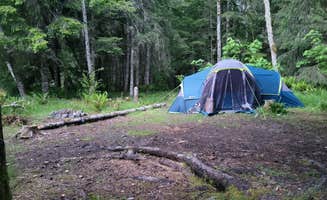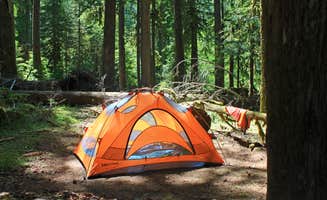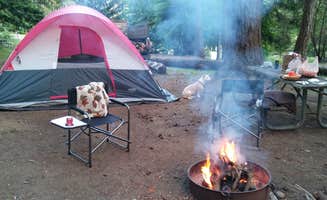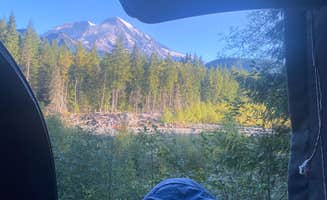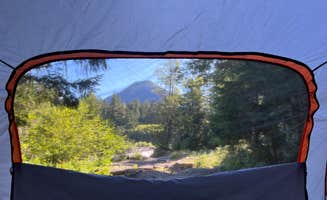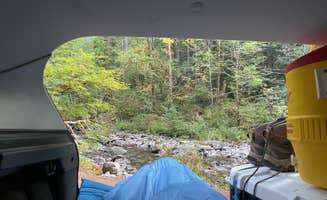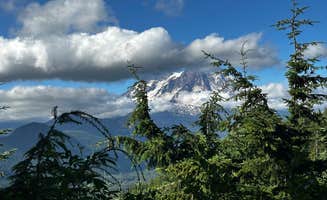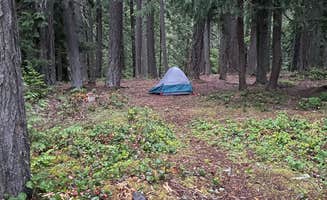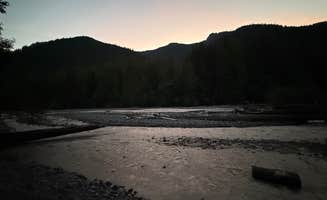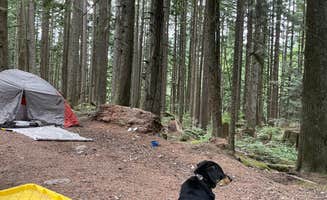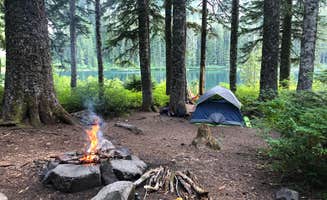Dispersed camping options near Orting, Washington offer primitive sites within Mount Rainier National Forest at elevations ranging from 1,800 to 3,500 feet. Most locations become inaccessible during winter months due to snow accumulation, typically from late November through April. The area receives approximately 70-100 inches of annual rainfall, creating lush forest conditions and multiple waterways throughout camping areas.
What to do
Hike to Ipsut Falls: Located less than half a mile from Ipsut Creek Camp, this short trail provides a quick side trip from your campsite. One visitor noted, "We visited Ipsut Falls, which was less than a half mile round trip out of camp, making for a sweet little trip to break up the day."
Watch aircraft activity: Ranger Creek Airstrip Dispersed offers a unique opportunity to see small planes land and take off. According to a review, "We were there during military skydiving practice. Very cool!" The airstrip sees light traffic, typically 3-5 planes per week during summer months.
Fishing opportunities: Multiple streams and rivers provide fishing spots throughout the area. At Forest Road 7300 Pull-Off, campers can access Huckleberry Creek, which one visitor described as having "lots of great creekside campsites along Huckleberry Creek with small swimming spots and fire pits to enjoy."
What campers like
Secluded spots: Away from more populated areas, free camping near Orting offers privacy. At White River Dispersed Camping, one camper found "a large secluded spot in the woods" after exploring beyond the riverside sites.
Water features: Streams and rivers create natural white noise. A camper at South Fork Snoqualmie River Dispersed Site shared, "Green as far as the eye can see, with a creek by that provides the perfect white noise to fall asleep to."
Wildlife viewing: Early mornings offer wildlife spotting opportunities. One visitor to Joemma Beach State Park Campground mentioned, "We did spot a bald eagle early in the morning," while others reported seeing deer frequently at various sites.
Cell service in remote areas: Some dispersed sites maintain connectivity. A camper noted that South Fork Snoqualmie River "hits the jackpot" for remote workers, stating "I have Verizon and have 2-3 bars of service."
What you should know
Seasonal challenges: Spring camping brings specific conditions. At Carbon River, a camper in June reported, "It is currently the beginning of June, cold at nights and the mornings. My fiance' and I are sleeping in a tent and it has rained a lot but if you go into the woods, you can still find dry branches for starting a fire."
Road conditions: Many access roads require higher clearance vehicles. For National Forest 84, a visitor warned, "The road itself if full of potholes, maybe wouldn't recommend if you have a old/ low to the ground/ 2 wheel drive car."
Donation system: Some free camping areas near Orting request small contributions. At Ranger Creek Airstrip, a camper explained, "There is a pay slash donation and worth every penny. Somewhere around $5 a day or if you're strapped for cash just cross your fingers."
Bug prevalence: Mosquitoes are common in warmer months. One camper at South Fork Snoqualmie River advised, "Seeing as there is water nearby, there are plenty of mosquitoes. Bring some bug spray!"
Tips for camping with families
Choose established sites: Areas with defined boundaries work better for groups with children. At Carbon River, a visitor mentioned, "We were so excited when we found a spot with a fire pit. We set up camp and started enjoying ourselves."
Consider short hikes: Cora Lake Back Country offers kid-friendly access despite being non-vehicle accessible. A parent shared, "Walked up for a night. Youngest was 11. Told the kids it was a 2 hour walk. Did it in under an hour."
Wildlife education opportunities: Many areas have small animals perfect for nature lessons. One camper noted, "We had a number of chipmunks running around our camp cleaning up any scraps left daily," providing natural wildlife viewing opportunities for children.
Weather preparation: Families should pack for temperature fluctuations. A camper at South Fork Snoqualmie River noted, "Super dark at night" and seasonal temperature variations can require extra clothing layers, especially at higher elevations.
Tips from RVers
Size-appropriate sites: Larger vehicles need specific locations. For Ranger Creek Airstrip, a camper with a large rig advised, "For larger rigs - take the second left at a Y-intersection, and then keep to the left and you won't have any trouble getting in. Going to the right at the Y takes you to an area that big rigs might have trouble finding spots or turning around."
Off-season advantages: Visiting during shoulder seasons provides better experiences. One RVer shared, "Best in late fall when it's cooler. Less loud drunkards. Can fit large RV's down a half mile rough road. I have been a few times in October/November in a 40 ft 5er."
Water sourcing strategies: No hookups means planning for water needs. One resourceful camper explained, "We went into Mt Rainier nat park and filled a 40 gallon tank from a waterfall along the road then pumped it into the rv."


